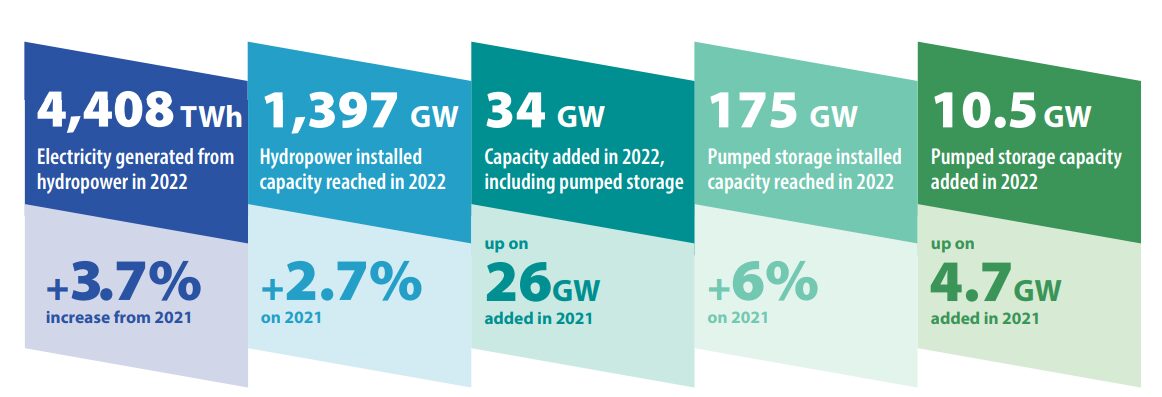Global hydropower: trend and unexpressed potential
The installed capacity of hydropower worldwide reached 1.39 million MW in 2022. But what is the actual global hydropower trend in recent years? Can the untapped potential be quantified?

by Frosio Next
July 2025
Global growth trends
According to the latest report from the International Hydropower Association (IHA), global hydropower capacity grew to its highest level since 2015 last year, reaching nearly 34,000 MW. The total installed capacity of hydropower worldwide reached 1.39 million MW. Despite these seemingly encouraging numbers, the significant efforts made globally by both the public and private sectors in recent years to transition to a more sustainable energy mix are still not in line with the roadmap for global zero-emission goals.
The increases in 2022 compared to the previous year are substantial and positive (see numbers in the image below), but to achieve a zero-emission economy, according to projections by the International Energy Agency (IEA), hydropower should grow at an average rate of approximately 46 GW per year. However, the current rate of development falls significantly below these levels. Between 2016 and 2021, hydropower grew at an average rate of 22 GW, only half of the required target. Furthermore, this rate was lower than the one recorded in the previous five years (2011-2016), which saw an annual average capacity addition of about 34 GW.

Source: IHA2023_WHO_report_04
Top countries for installed capacity in 2022
In the past year, the most significant growth in hydropower capacity occurred in East Asia and the Pacific. Thanks to 24,944 MW of new capacity additions, the total installed capacity in the region increased to 548,000 MW. China continues to lead the way, with nearly 24 GW of new capacity coming online in 2022, including the latest units from the massive 16 GW Baihetan project (16 hydropower units!). China’s new capacity included over 8 GW of pumped hydro facilities, reflecting its ambitious plans for this category of plants, which could see up to 270 GW of capacity by 2030. In the region, only Laos (with over 1 GW of new capacity) represented an alternative to China’s dominance in terms of annual new installed capacity.

Source: https://www.aa.com.tr/en
In Central and South Asia, nearly 2 GW of new capacity has been installed, including large projects in Pakistan (Karot, 720 MW) and India (Bajoli Holi, 180 MW), with many large-scale projects nearing completion and set to be operational in the 2024/25 timeframe. In a further positive development, the Indian government recently released guidelines for hydro-pumping projects, recognizing their importance in providing grid services and support as the Indian grid increasingly accommodates growing numbers of variable renewable energy sources (wind and solar).
One of the most unexpected developments in 2022 was the significant increase in hydropower capacity in Europe. Europe added 2,712 MW of new installed capacity, with 1,780 MW coming from pumped hydro projects. The total installed hydropower capacity in Europe reached 258,000 MW (Portugal with 998 MW and Switzerland with 900 MW led the 2022 expansion in capacity).
In North and Central America, the installed capacity reached 1.14 million MW, with 1,011 MW of new installations. Both North and South America saw an increase of over 1 GW of new capacity in 2022, with significant increases in Canada (over 1 GW), Colombia (618 MW), and Chile (477 MW) thanks to various large new power plants. In North America, positive contributions were noted from governments (in the United States with the Inflation Reduction Act and in Canada, where the 2023 budget will incentivize hydropower development through innovative tax credit schemes).

In Africa, the total capacity was 40,000 MW, with capacity additions of 1,860 MW. Countries in South and Central Asia added 1,940 MW of new capacity in 2022. The total installed capacity in the region reached 164,000 MW. Steady progress continues, with just under 2 GW added in 2022, including a series of large projects over 50 MW (in Ethiopia, Guinea, and Zambia) and smaller projects (including in Madagascar, Uganda, and Rwanda) commissioned with the support of both private and public investments. Although much work remains to be done to increase hydropower in Africa, significant projects are planned for the coming year in Angola (Caculo Cabaça, 2 GW) and in Cameroon (Nachtigal, 420 MW), which will aid the continent in its transition to clean energy.
Future prospects per region

Source: IHA2023_WHO_report_04
Find out more news
ISO 9001 and ISO 14001 Certifications: importance and benefits
Let's explore the benefits and significance of the ISO 9001:2015 and ISO 14001:2015 certifications.
Frosio Next article published on Hydropower&Dams (Issue 6)
Frosio Next article published on Hydropower & Dams magazine (Issue 6)
FROSIO NEXT, not only hydropower plants: construction of a revetment wall in the riverbed of Mella river
FROSIO NEXT carried out the design and the construction of a revetment wall in the riverbed of the Mella river in order to protect the foundations of some buildings in Gardone Val Trompia (BS).
Contact us
Do you want to start a great project with us?
Fill the form and get in touch with us.








